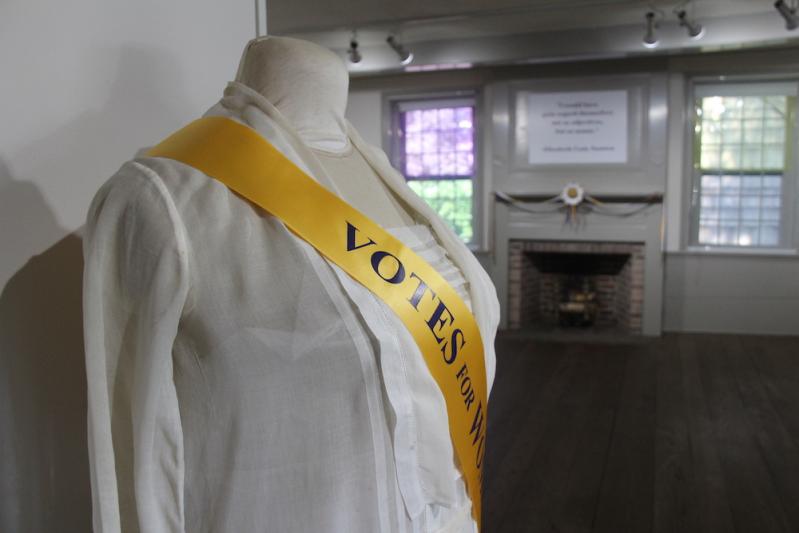“Votes for Women: A Portrait of Persistence,” a one-day exhibition to mark the 100th anniversary of women’s right to vote, will be at the East Hampton Historical Society’s Clinton Academy museum on Saturday.
The exhibition will include posters on loan from the Smithsonian Institution supplemented with objects from East Hampton’s suffrage story. Admission is free, but advance registration on the East Hampton Historical Society’s website is required, as drop-in admission will not be permitted. During the exhibition hours, from 10 a.m. to 2 p.m., the League of Women Voters of East Hampton, Shelter Island, and the North Fork will offer assistance with voter registration.
Richard Barons, the historical society’s chief curator, spoke to the ways in which the suffrage movement has suffered from lack of easily findable documentation. “I mean, this is always the problem that museums, archivists, curators have -- there are often amazing events that happen, but how many times do they get photographed, how many times do they get mentioned in the newspaper?”
“Boy, it’s interesting when you look at a book which is basically about local history and a good number of the photographs are Getty images!” he said.
A collection of 10 panels from the Smithsonian helped align an overview of suffrage on the East End with the movement’s main frame in the United States. With 24 black-and-white photos, Mr. Barons said the society was able to “augment the story.”
Images from Long Island, Boston, New York, and Washington, D.C., help “put a face to some of the stories on the posters,” he said.
The curator found himself looking at the photos of parades and pageantry for a while before realizing the meaning of certain details. “I found it interesting that almost always there was a woman driving a car or a woman driving a wagon with a horse. And, of course, it didn’t dawn on me, being a male, that that was an unusual thing to happen in the 1890s.” Hot-air balloons, airplanes, and dirigibles were “all part of a framework of the suffragist movement, making a point that women could do all these things.”
One Getty photo in the exhibit that struck Mr. Barons is from New York and shows two women aviators. “I think they probably had a silly name like ‘aviatrix’ or something during that period.” Around 1913, as women in aviation, they were jobless but nonetheless knew how to fly. They planned to “fly down and drop off leaflets over the White House because Wilson was in the White House that particular weekend.”
The wind prevented the biplane from getting far that day, “but it just was a point to let me know, because I certainly didn’t know that, that was the reason the airplane was chosen, they would choose things that women were not known to do or ‘respectable’ women didn’t do.”
Photographs of parades, women being arrested, are all “close to home” at the moment, Mr. Barons pointed out. Some images capture the negativity directed toward the marching women: kids throwing stones at the suffragists, for instance. “I mean, it could be on the TV today, right?” Mr. Barons said.
In his favorite image of the exhibition a young woman of 18 or 19 “looks like she’s just getting ready to go on a march. And she’s attached her American flag to her broomstick, complete with broom.”
There are challenges to mounting an exhibition during Covid, Mr. Barons explained. Most archives are not open, and if the archives are not already on the internet, there’s no telling what photographs they have. Whether or not they can or will even get their stock scanned depends on if there is anyone working in the archives.
But, said Maria Vann, the executive director of the East Hampton Historical Society, “We did not want this challenging year to prevent us from marking this historic anniversary and sharing what we could with the community about this important narrative of women’s tenacious spirit and fortitude to be enfranchised.”
Thanks to the research of an intern who looked up every mention of suffrage in every issue of The East Hampton Star since the 1880s, Mr. Barons hopes down the line to be able to focus in more on some of the major players in the movement here or understand the extent to which the Ladies Village Improvement Society might have played a role.
“We haven’t found any floats of the parades out here that are suffragist floats. Is that because it was a male taking the photographs and he didn’t want to photograph it?” he wondered.
Another thing that remains to be investigated is the sorts of women involved in marches. Wealthy women’s participation is most documented, but Mr. Barons wonders if in the library’s records of women’s day books with minutes from, for example, sewing organizations, there could be mention of the feeling toward those who participated in the movement at the time.
“The photographs tend to give the illusion that you’ve got a lot of Caucasians. That could be merely because most people who took pictures of parades during that period took a picture of the beginning of the parade. So then after that you’d have all the people, national people and local people and county people. When you see the mobs of people, you’re really just seeing the tops of their heads.” There is still much work to do in order to “place it,” as Mr. Barons said.
Mr. Barons learned that some women decorated their carriages or cars and drove all the way from Boston to big Washington marches, touting their cause along the way.
In the 1890s, when soldiers who had fought in Cuba during the Spanish-American War were quarantining at Camp Wikoff in Montauk, many women banded together and made bandages, got medicine, opened temporary hospitals, and even made cookies or took food to soldiers when the train stopped at the train station, Mr. Barons said. A number of soldiers wrote letters to The East Hampton Star thanking these women.
Edward S. Boughton, the editor of The East Hampton Star at the time, wrote on Oct. 7, 1898, “These ladies have found pride in banding together and finding solutions to problems that stymied the army and the federal government. I can hardly wait to see what this new power of leadership will produce. When it comes to social ills, there will be no stopping this newfound energy of our women and it is a new world.”
“That is a hell of a quote,” Mr. Barons said.




